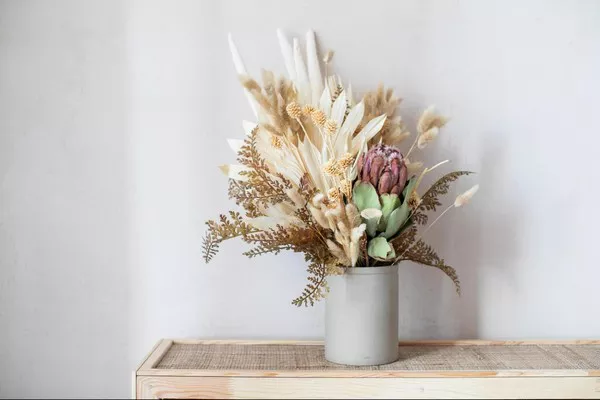In the realm of artistic expression, dried flowers offer a unique and captivating medium. Their delicate forms and preserved colors evoke a sense of nostalgia and beauty that can be preserved indefinitely in art. Whether you’re a seasoned artist or a novice exploring new creative avenues, working with dried flowers opens up a world of possibilities. This comprehensive guide will walk you through everything you need to know about making art with dried flowers, from sourcing materials to advanced techniques that will elevate your creations.
Getting Started: Materials and Preparation
Before delving into the artistic process, it’s essential to gather the necessary materials and prepare your workspace. Here’s what you’ll need to get started:
1. Dried Flowers: Select a variety of dried flowers with different shapes, sizes, and colors. Roses, hydrangeas, baby’s breath, and lavender are popular choices for their durability and aesthetic appeal.
2. Backing Material: Choose a sturdy backing material for your art piece, such as canvas, wood panel, or heavy paper. The size and shape of your backing will depend on the type of artwork you envision creating.
3. Adhesives: Use a strong adhesive suitable for dried flowers, such as craft glue or a glue gun. Make sure the adhesive is clear-drying to maintain the natural appearance of the flowers.
4. Sealant: To protect your artwork from dust and preserve the colors of the flowers, invest in a quality sealant. Matte or glossy options are available depending on your preference.
5. Tools: Prepare basic tools like scissors, tweezers, and a paintbrush for applying sealant. These tools will aid in handling delicate flowers and achieving precise results.
Selecting and Preparing Dried Flowers
Choosing the right dried flowers is crucial for creating visually appealing artwork. When selecting flowers, consider the following:
Color Palette: Decide on a color scheme that complements your artwork’s theme or intended mood. Vibrant hues can create a lively composition, while pastel shades evoke a softer, more delicate feel.
Texture and Shape: Mix flowers with varying textures and shapes to add depth and interest to your artwork. Consider incorporating foliage or grasses for added dimension.
Condition: Ensure that the dried flowers are in good condition without signs of mold or brittleness. Handle them gently to prevent breakage.
Once you’ve chosen your flowers, you may need to prepare them before incorporating them into your artwork:
Trimming: Use scissors to trim any excess stems or leaves from the dried flowers. This will make them easier to arrange and adhere to your backing material.
Arrangement: Experiment with different arrangements of flowers on your backing material before gluing them down. This step allows you to visualize the final composition and make adjustments as needed.
Techniques for Creating Art with Dried Flowers
1. Pressed Flower Art
Pressed flower art involves arranging dried flowers and foliage between sheets of absorbent paper and applying pressure to flatten them. Here’s how to create pressed flower art:
Pressing Method: Place flowers between sheets of blotting paper or newspaper, then insert them into a flower press or heavy book. Leave them to press for 1-2 weeks, depending on the thickness of the flowers.
Arrangement: Once pressed, carefully arrange the flowers on your backing material using tweezers or a small paintbrush dipped in glue. Press gently to adhere them to the surface.
Finishing Touches: Seal the artwork with a coat of sealant spray to protect the delicate flowers and enhance their colors.
See Also: How to Press Flowers on Canvas
2. Decoupage with Dried Flowers
Decoupage involves layering pieces of paper or fabric onto a surface and sealing them with glue or varnish. Here’s how to incorporate dried flowers into decoupage:
Preparation: Arrange dried flowers on your chosen surface, such as a wooden tray or box lid. Use a paintbrush to apply a thin layer of decoupage glue or Mod Podge to the surface.
Layering: Carefully place each dried flower onto the glue, overlapping them slightly to create a cohesive design. Press down gently to ensure they adhere securely.
Finishing: Apply additional coats of decoupage glue over the flowers, allowing each layer to dry completely before applying the next. Finish with a final coat of sealant for durability.
3. Three-Dimensional Artwork
For those looking to create more intricate and three-dimensional pieces, consider the following techniques:
Shadow Boxes: Arrange dried flowers and other natural elements within a shadow box frame. Layer different materials to create depth and visual interest.
Sculptural Art: Use dried flowers to embellish sculptures made from wire, clay, or papier-mâché. Incorporate flowers as accents or create entire floral motifs.
Mixed Media: Combine dried flowers with other mediums such as watercolor, acrylic paint, or ink to create mixed-media artwork. Experiment with textures and techniques to achieve unique effects.
Preservation and Care
Properly preserved dried flower art can last for years with minimal maintenance. Follow these tips to ensure longevity:
Avoid Direct Sunlight: Display your artwork away from direct sunlight, as prolonged exposure can cause colors to fade over time.
Regular Dusting: Dust your artwork gently with a soft brush or feather duster to prevent buildup and maintain its appearance.
Temperature and Humidity: Keep your artwork in a stable environment with moderate temperature and humidity levels to prevent deterioration.
Finding Inspiration and Evolving Your Style
As you gain experience working with dried flowers, take time to explore different techniques and styles. Draw inspiration from nature, art history, and contemporary artists to develop your unique artistic voice. Experiment with color combinations, composition, and scale to push the boundaries of traditional floral art.
Conclusion
Creating art with dried flowers is a deeply rewarding endeavor that allows artists to capture the ephemeral beauty of nature in timeless compositions. Whether you’re creating delicate pressed flower bookmarks or elaborate mixed-media installations, the versatility of dried flowers offers endless possibilities for artistic expression. By mastering the techniques outlined in this guide and allowing your creativity to flourish, you’ll embark on a journey of discovery and creation that celebrates the enduring allure of botanical artistry.


